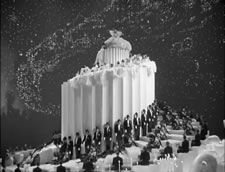
The Ziegfeld Follies
Ever wonder how dance and film began their two-step? We waltz or way through some of the key milestones in the dance film timeline...
1839 François Delsarte creates a manual for acting, explaining how appearances and actions can convey particular emotions.
1894 Thomas Edison films Ruth Dennis doing a skirt dance.
1898 Konstantin Stanislavsky develops a style of acting known as the System. It requires actors to create roles by working from the inside out, using their own experiences to convey emotion and realism rather than basing their characters on things such as costume and makeup.
1902 Peter Elfelt films the Royal Danish Ballet.
1905 First regular cinema (Pittsburgh, Pennsylvania).
1916 Intolerance. Denishawn dancers appear in Griffith’s landmark epic. Ruth Dennis, who choreographs the impressive Babylonian dances, is now Ruth St Denis, a major influence in the history of modern dance.
1928 Diaghilev uses film projections in Massine’s ballet, Ode.
1928 Eisenstein makes a fast montage of soldiers dancing in different styles in his film, October.
1929 Lavish all-dancing, all-singing revue films start to appear.
1933 Filmmaker and choreographer Busby Berkeley begins a run of large-scale dance movies featuring innovative kaleidoscopic camerawork. The techniques are an early forerunner of music videos.
1933 Flying Down To Rio. First of the Fred Astaire and Ginger Rogers films, although they are not the main stars. Public and critical response to their Carioca dance routine secures their future partnership in movies. They will make a further nine films together (which you can read about here).
1935 Top Hat. Fred Astaire and Ginger Rogers dance together more times in this film than any other. A beautiful ostrich feather gown in the Cheek To Cheek number constantly sheds feathers - showing an advantage of film over stage performance.
1936 The Great Ziegfeld. Biopic of Florenz Ziegfeld, founder of the theatrical institution, The Ziegfeld Follies (upon which many dance movies were being based).
1936 Follow The Fleet (Fred Astaire and Ginger Rogers). Amateurs from a local dance hall were spliced into the Let Yourself Go number, demonstrating an advantage of film, since it allows dancers not available for the stage to be used.
1936 Swing Time. Fred Astaire likes his dance numbers to be one continuous camera shot, but in the Never Gonna Dance routine, a cut is necessary to bring the camera up the stairs and shoot the finale. That climax requires 47 takes and Ginger Rogers’ feet are bleeding after so many demanding spins.
1939 First TV sets.
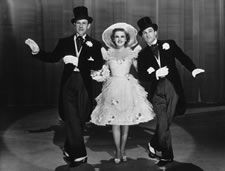
1942 For Me And My Gal. Gene Kelly’s film debut, and the first of four films he will make with Judy Garland. Directed by Busby Berkeley.
1942 Holiday Inn. Fred Astaire consumes bourbon to get him in the mood for the ‘drunk dance.’
1943 Meshes Of The Afternoon. Dancer-filmmaker Maya Deren’s avant-garde short film uses a staggered repetition of image and character to create a sense of paranoia in the viewer.
1944 Cover Girl. Gene Kelly dances with himself using special effects.
1945 A dance series appears on TV – CBS’s Choreotones.
1945 A Study In Choreography For Camera by Maya Deren allows a dancer to use filmic rather than real space.
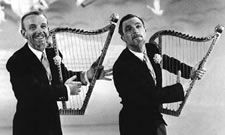
1946 Ziegfeld Follies. One of only two films in which Gene Kelly and Fred Astaire dance together.
1947 The Actors Studio is formed. Method acting develops, influenced by the teachings of Stanislavsky.
1948 The Red Shoes. Said to have been inspired by the real-life meeting of Sergei Diaghilev with the British ballerina Diana Gould.
1948 Easter Parade (Fred Astaire and Judy Garland). It includes some hilarious routines, as Astaire plays an over-confident dance teacher trying to bring chorus girl Judy Garland up to speed. Her confusion between Astaire’s dance-persona affection and his real feelings is a trap every social dance enthusiast will recognise. The common plot device will be repeated exactly in Strictly Ballroom in 1992.
1949 On The Town (Gene Kelly). For the first time in a movie, and for one dance sequence, four trained ballet dancers subbed for four of the leads - Frank Sinatra, Jules Munshin, Betty Garrett, and Ann Miller.
1951 An American In Paris. Includes a 17-minute ballet danced by Gene Kelly and wins an Academy Award.
1951 Royal Wedding. Extensive long shots to keep Fred Astaire's full body in frame as he dances. It features unique use of cinematic space in a sequence where Astaire dances up and down walls and on the ceiling.
1951 Trance And Dance In Bali (Gregory Bateson and Margaret Mead). Dubbed 'culturally significant' by the United States Library of Congress.
1952 Singin’ in the Rain (Gene Kelly). One of the most popular movies of all time. Most of the famous scene in the rain is ad-libbed, with Kelly ill and running a high temperature. Also famous for its dances on tabletops, sofas, stairs and deserted steps.
1953 CinemaScope introduced by Twentieth Century Fox, with an aspect ratio of 2.35:1.
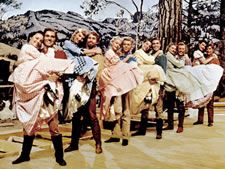
1954 Seven Brides For Seven Brothers is one of the first dance films shot in wide-screen format.
1956 NBC broadcasts the Sadler Wells Ballet in Sleeping Beauty to an audience of around 30 million.
1956 First video recorder.
1956 The Dance Films Association is founded to promote excellence in dance on camera and public awareness of the artform.
1956 A Moment In Love. Shirley Clarke uses abstract line and colour to capture pure dance.
1957 Silk Stockings. Fred Astaire will effectively retire from musicals after this film. His dancing partner Cyd Charise’s legs fall foul of the censor.
1959 Bridges-Go-Round. Directed by Shirley Clarke, a Martha Graham–trained dancer. She makes the bridges of New York ‘dance’ with various film techniques.
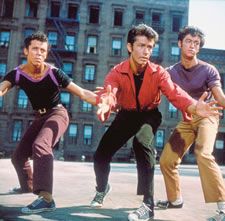
1961 West Side Story. Adapted from a stage play loosely based on Shakespeare’s Romeo And Juliet, it involves street-fights-as-dance between rival gangs.
1964 A Hard Day's Night. The Beatles vehicle is influenced by the rapid cuts of the French New Wave. Often seen as a precursor to the music video, it makes ample use of handheld cameras, zooming, and fast- and slow-motion. The cinematography effectively creates a ‘dance’ of movement around pop stars that cannot dance.
1968 Isadora. Biopic of Isadora Duncan, considered by many to be the mother of Modern Dance.
1969 They Shoot Horses Don’t They. Nine-time Oscar nominated film, directed by Sydney Pollack and starring Jane Fonda and Michael Sarrazin. About a 1930s six-day dance marathon.
1969 First video cassettes.
1971 First Dance on Camera Festival.
1972 Cabaret. Directed and choreographed by Bob Fosse. Wins eight Oscars, including acting honours for Joel Grey and Liza Minelli, best director and best editing.
1974 That’s Entertainment. A guide to popular film choreography with more than 100 numbers from musicals, comedies and dramas. Fred Astaire, Gene Kelly, Cyd Charisse. And more.
1976 VHS is introduced.
1976 The Steadicam is introduced, a camera mount that imitates the fluidity of a dancer’s body.
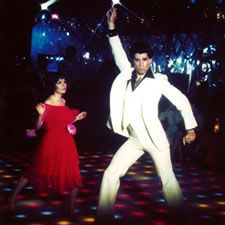
1977 Saturday Night Fever, starring John Travolta turned the disco-dancing star into a sex symbol. One of the first films to use the Steadicam.
1977 Start of the home video era.
1978 Start of the digital era.
1979 All That Jazz. Directed and choreographed by Bob Fosse, a semi-autobiographical fantasy based on aspects of the dancer/choreographer/director's life and career. A landmark film that shows his genius and lays bare his concerns.
1979 Four Journeys Into Mystic Time. Shirley Clarke’s set of four thematically related dance pieces. Dancers appear in their own pools of light, with no external props.
1980 Fame. Alan Parker's Oscar-winner (best music, best song) tells the stories of performing arts students.
1983 Flashdance. Popular trappings from ballet lend seriousness to an exotic dancer’s search for a professional dance career. Polysemic readings of the film allow it to be enjoyed by both feminist audiences and those embracing the male gaze of the objectified female body. Music video editing techniques emphasise rhythms and pacing to heighten audience acceptance. Editing and lighting successfully disguise the use of a stand-in for the main dance scene.
1983 Staying Alive. Sylvester Stallone directs John Travolta as he reprises the role of Tony Manero, who aims to become a dancer on Broadway.
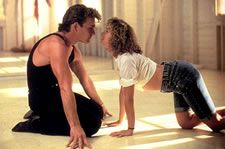
1983 Carmen. The first (and probably the best) of Carlos Saura’s three films about dance.
1984 Footloose. Loosely based on a ban on dancing that was enacted in a small community, it stars Kevin Bacon in central role.
1985 Divine Horsemen: The Living Gods Of Haiti. Maya Deren’s ethnological examination of ritual dance (posthumously assembled footage).
1985 A Chorus Line. Musical about 17 Broadway dancers auditioning for spots on a chorus line. Adapted from a long-running theatre show, it delves into the emotions and personalities driving the aspiring performers.
1987 Dirty Dancing. Favourite film of jive dancers. Helped to popularise the UK ‘ceroc’ craze.
1989 Introduction of the Media Composer, a computerised device allowing nonlinear editing.
1992 Strictly Ballroom. Award-winning film that pokes affectionate fun at the self-seriousness of flamenco and ballroom. Features professional dancer, Paul Mercurio.
1995 Flamenco. Carlos Saura aims to show the passion within the dance, stripping away the trappings of Hollywood to focus on the dancers.
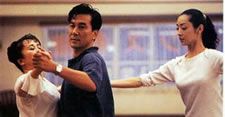
1996 Shall we Dansu? Japanese cultural embarrassment over close public contact is mirrored in the faltering steps of the ballroom student. (A re-make in 2004 with Richard Gere and Jennifer Lopez succeeds in missing the point.)
1997 The Tango Lesson. Sally Potter’s semi-autobiographical film where she learns the spirit and technique of the tango. Includes remarkable tango scenes indoors, outdoors and in the rain.
1998 Tango. Third in the triumverate of dance films by Carlos Saura sees a dancer get involved with a mafia boss.
2000 Center Stage. Story of teenagers joining the NY American Ballet Academy. Includes more actual dance footage than in many mainstream movies.
2000 Dancer In The Dark. Controversial film that choreographs everyday environments such as a factory interior and a moving train, providing a fantasy world that uplifts a disadvantaged blind girl.
2000 Billy Elliot. Award-winning film that makes the ballet dancing aspirations of a young working class lad look ‘manly’.
2001 Save The Last Dance. Hip-hop crosses with ballet.
2001 Imperatriz do Carnaval. Documentary following a samba school’s preparations for the largest popular arts/dance event in the world.
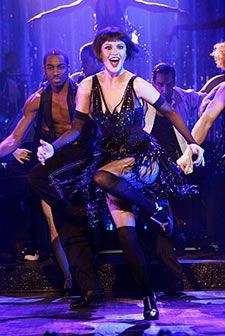
2002 Chicago. Very successful adaptation of a stage song-and-dance production, even though most of the stars have little or no dance experience. Won six Oscars.
2003 Video market outstrips box-office.
2005 Mad Hot Ballroom. Documentary showing a beneficial effect ballroom dance classes have on schoolchildren in a deprived area of New York.
2007 Om Shanti Om becomes one of the highest grossing Bollywood films ever, in both Indian and Western markets.
2008 Mamma Mia! Immensely popular musical based on hits by pop band Abba. Bachelor and bachelorette parties involve the entire cast converging in chorus-line extravaganzas.
2009 Only When I Dance. Two young kids try to dance their way out of the favelas of Rio de Janeiro.
The Dance:Film Festival runs in Edinburgh from May 21 to 30. You can read our coverage here and view the full schedule of films and events on the official site.





















